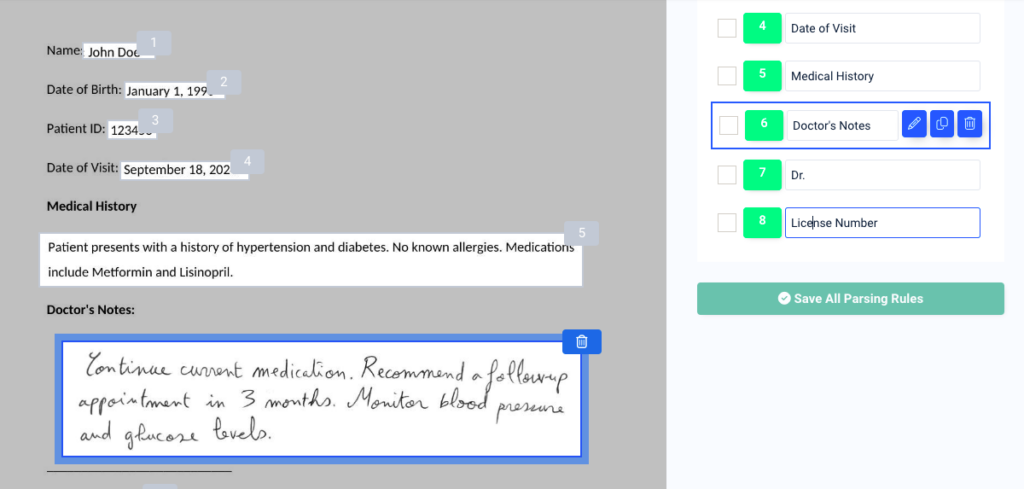The recent launch of DocparserAI has paved the way for a lot of new features, allowing users to parse documents more efficiently and accurately than ever. Now, when using the SmartAI Parser template, you have access to a brand new parsing feature: handwriting recognition.
If you work with documents that contain handwriting, you’re going to love this feature. Using the power of AI, you can now convert handwritten text into machine-readable data. As a result, you save more time, prevent errors and readability problems, and make handwritten information easily accessible digitally. In this blog post, we show you how to use our handwriting recognition feature and discuss three practical applications in different industries.
Extract Handwritten Information from Your Documents Easily
Capture both digital and handwritten data and streamline your document-based workflows.
No credit card required.
Why Handwritten Text Is Hard to Process
Handwritten notes are still common to this day. They are present in a plethora of documents, from medical records to tax forms, loan applications, and a lot more.
Here is where things get complicated. Every person has unique handwriting, which can even vary at times. Additionally, handwritten text often has irregularities like letter formation, uneven spacing, misspellings, slants, varying sizes, overlapping letters, smudges, etc. This lack of uniformity makes it difficult for data extraction tools to identify characters accurately.

Moreover, people can have trouble with text legibility. One individual may be able to understand a handwritten note while another will struggle to make sense of it. Ultimately, even though you can extract digital and printed text, you may still have to type handwritten text manually.
To help people overcome this challenge, we have added handwriting recognition to the capabilities of SmartAI Parser.
Introducing Our Handwriting Recognition Feature
We’re happy to introduce our AI-powered handwriting recognition parsing feature.
Without delving into the technical details, think of it as OCR for handwritten text. Now Docparser users can extract that information from documents and export it to their systems, quickly and accurately. The days of manual transcription are over!
Here is why you’re going to love this new feature.
Digitize handwritten notes hassle-free
If you have tried handwriting recognition software before, there’s a chance you noticed some inaccuracies or had to sit through long processing times. Or maybe you couldn’t integrate that tool with your business applications.
We’re happy to tell you that DocparserAI makes the process of extracting handwritten text a breeze. Forget about data entry and subpar tools. DocparserAI parses your mixed-text documents accurately, ensuring that your document processing workflows are hands-off.
As for digital or printed data, you can extract it as usual with DocparserAI’s intelligent rule creation. You get a collection of parsing rules within seconds, and then you can customize them to adjust the parsing results.

Export data to your favorite cloud apps
Our users are familiar with the automation possibilities enabled by our integrations. Docparser integrates with over 6,000 apps and platforms via webhooks and API. After extracting data from your documents, you can send it to a cloud application or even an HTTP endpoint. Once set up, important data can flow seamlessly from documents into your systems and databases, allowing you to dedicate your time to more important and rewarding work.
Your data is safe
As more organizations and individuals adopt AI technologies, there is a growing concern about user privacy. Users are rightfully apprehensive about how their data is collected, stored, and used.
At Docparser, we understand these concerns and address them. In addition to taking all necessary measures to ensure data security, we want you to rest assured that DocparserAI does not store user data or use it to train AI models like NLP or LLM.
This new parsing feature will prove particularly useful for professionals who work in industries such as insurance, healthcare, finance, and more. We’ll take a closer look at this in a bit, but first, let’s see how it works.
Extract Handwritten Information from Your Documents Easily
Capture both digital and handwritten data and streamline your document-based workflows.
No credit card required.
Getting Started With Handwriting Recognition
For this example, we’re using a mockup medical record that includes handwritten notes from a doctor. We’re going to extract both the doctor’s notes and the other data fields which are in digital format. To do this, follow these steps:
1. Log in to your Docparser account (or sign up) and create a new parser.
2. In the template library, select the SmartAI Parser template, which includes the handwriting recognition feature. Type a name for your parser and click on ‘Continue’.

3. Upload a sample document and wait for a moment while SmartAI Parser creates parsing rules.

4. Review your parsing rules and edit them if needed. Let’s check the doctor’s notes:

5. Send your data where it belongs. Either download it or export it to a cloud application that you use via an integration. For example, we can send the parsed data to an EHR (Electronic Health Record) system via Zapier.
This process was pretty straightforward, you feed SmartAI Parser a sample document and it identifies the relevant data fields for you. Then you adjust the AI outputs if needed and prepare your data for automatic export. Simple, quick, and accurate!
We mentioned above a few industries where AI handwriting recognition can be a game-changer. To give you a better idea of the efficiency gains, here are three use cases for this new parsing feature.
3 Use Cases That Boost Efficiency
In addition to common use cases like capturing handwritten forms, handwriting recognition has major applications in several industries. We’d like to give you three examples of how its implementation can yield huge benefits.
Digitizing historical documents
Thousands of valuable historical documents are sitting in libraries, museums, and archives, waiting to be transcribed. The process of transcribing handwritten records manually is painstakingly slow and error-prone, but with the advent of handwriting recognition, things are changing.
Now, countless historical documents can be digitized in their entirety thanks to handwriting recognition. Archivists, historians, researchers, and others are better able to prevent the loss of valuable records from degradation and disasters. Plus, they can build digital libraries that are available to the public at a faster rate and with higher accuracy. This goes a long way to preserve culture and history for future generations.
Healthcare (Doctor Handwriting Reader)
Healthcare professionals typically jot down notes on various documents like prescription forms, patient enrollment forms, progress notes, etc. Doctors in particular are often too busy or in a hurry to type notes into a digital record, so other employees must do it. However, they may misread or mistype information, leading to delays and even errors in treatment.
However, after the switch to handwriting recognition, all notes are captured accurately. What once took hours of manual transcription and cross-checking is now seamlessly integrated into electronic health records (EHRs), making every information readily accessible. Doctors can collaborate faster, patient care improves, and the administrative burden shrinks. As a result, healthcare professionals have more time to focus on what matters most: the patients.
Banking and finance
Companies in the banking and finance sectors always have to process handwriting found in forms, checks, loan applications, insurance claims, and a myriad of other documents. This often leads to slow transaction times and dire mistakes.
Because of this, handwriting recognition represents a huge opportunity to reduce operational costs and speed up processes. For starters, employees can swiftly capture handwritten data. It also becomes much easier to store, retrieve, and audit. Furthermore, approval processes take much less time than before, which enhances the customer experience.
Start Extracting Your Handwritten Data Today
At Docparser we do our best to address user requests and welcome any feedback. We’re always working to make Docparser the best parsing tool available, no matter what industry you operate in or what your parsing needs are.
Our AI-powered parsing engine has made handwriting recognition more accurate, flexible, and accessible than other tools out there. If you handle documents that contain handwritten data, take advantage of handwriting recognition and boost the efficiency of your document-based workflows.
Extract Handwritten Information from Your Documents Easily
Capture both digital and handwritten data and streamline your document-based workflows.
No credit card required.




